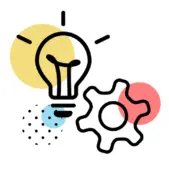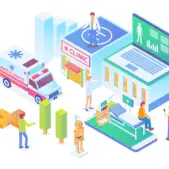A website redesign is no simple task. Regardless of your business size and type, you want to ensure your investment will increase profits, grow your brand, and improve the user experience. To do this, you need the right skills, expertise, and a team that can stick to your budget and timeline.
In this guide, we explore the pros and cons of using an agency, freelancer, or in-house team to secure the best results. Because every business is different, we also discuss key considerations for choosing a redesign partner specific to your needs. While there might not be a one-size-fits-all solution, these tips and insights will help you make an informed and strategic decision.
Considerations When Looking for a Website Redesign Partner
When choosing a website redesign partner, consider the following factors to ensure the desired transformation aligns with your business goals and fits your budget.
1. Scope of Work and Scale of Project
A well-defined scope of work ensures the project stays on course. It also can prevent scope creep, which occurs when a project deviates from its original plan.

A well-planned website redesign scope should outline the project from beginning to end. This may include:
- A project timeline
- Functional and design specifications
- Contractual agreement
- Quality assurance procedures
- Budget
- Site launch plan
- Post-launch plan
- Support plan
Deliverables may include check-ins, progress reports, and site prototypes.
This predetermined brief of requirements offers a baseline for expectations and a consistent reference point to gauge which type of partner would be best.
Partner Pros and Cons Based on Project Scope
In-house teams may lack specialized skills or experience in certain areas of a website redesign including a big picture strategy.
However, a website redesign project may span too wide a scope for any one freelancer. Full redesigns often touch business, design, and technology, which may require various sets of expertise and skills.
Most agencies are equipped to handle a variety of project sizes and complexities. A reputable agency can adjust its resources and capabilities to meet the specific needs of a project.
2. Timeline
A website redesign timeline serves as a structured plan that outlines key milestones in a project. It fosters a shared understanding between all parties regarding the progression and timing of each step in the web project. This timeline eliminates ambiguity by clarifying tasks, schedules, review dates, and estimated project completion.
An effective website redesign timeline is crucial for maximizing profitability. When you establish clear expectations and accountability for both parties, you mitigate potential roadblocks. This leads to a smoother project delivery.
Of course, a website timeline alone can’t completely prevent project overruns. But clear communication and documentation play vital roles in averting unforeseen costs and delays. Without a detailed breakdown of project tasks, you may struggle to grasp the complexities of website development, resulting in confusion and unrealistic expectations.

A timeline should always include:
- Production time
- Presentation dates
- Feedback dates
- Copywriting time
- Revision dates
- Approval dates
- Testing time frames
- Launch date
Partner Pros and Cons Based on Project Timelines
Your in-house team typically serves numerous departments, working on multiple projects or tasks at any given time. When you assign your website redesign to your in-house team, it likely won’t be the only project they focus on. This means the redesign may not get the full attention and urgency it needs.
On the other hand, if a freelancer works as a one-man-show, they may struggle to complete the redesign in the set time frame. This can be further exacerbated when revisions and adjustments are required.
A competent agency has the resources and skills to quickly increase project momentum. This can expedite the redesign process, likely completing it faster than other alternatives.
3. Size of Business
The size of your business can be a big determinant in who you should choose as a website redesign partner. For small businesses, budget constraints often shape their decisions. The simplicity of a small business organizational structure allows for quick decision-making. Freelancers are often an attractive choice due to their flexibility and affordability.
What’s more, small businesses typically focus on local or niche markets. This allows for a faster and more streamlined customer research process before the redesign begins.
Conversely, the complex organizational structure of large businesses involves multiple stakeholders. This calls for extensive coordination across departments like marketing, IT, and customer service. Because it targets a broader, often global audience, a large business will need to focus on diverse content strategies while maintaining brand consistency.
Large-scale businesses require websites that can handle high-traffic volumes and integrate complex features such as eCommerce and CRM systems. With dedicated teams for maintenance, there’s a focus on continuous updates, security, and compliance. There’s also a push to incorporate the latest technologies and innovative solutions to stay competitive in the market.

Agencies are likely a better choice for large businesses because they have more extensive resources and project management capabilities. Agencies can also provide an outside-in perspective and experience across a range of projects and industries. This can be invaluable when tackling complex problems that may be causing internal conflict or stalemate.
4. Cost
The cost implications of hiring different partners for a website redesign vary based on expertise and available resources.
When you use your in-house team, you’re utilizing existing staff members to handle the redesign. While the upfront website redesign costs may appear lower, as salaries are already accounted for, there are hidden expenses. For instance, allocating time away from core duties, potential training costs for acquiring new skills, and ongoing maintenance expenses post-redesign. However, the benefit lies in leveraging internal knowledge and maintaining control over the project.
Consultants or freelancers may offer specialized expertise for specific phases of the redesign project. Their costs are typically project-based or hourly, making them a flexible option. While they can provide cost-effective solutions for short-term projects, long-term engagements can get expensive thanks to the continuous need for their services.
Using an agency for your website redesign often entails higher upfront costs due to its comprehensive services, extensive resources, and experienced team members. However, agencies bring a wealth of industry knowledge, creative capabilities, and project management expertise to the table.
They offer a one-stop solution for all aspects of the redesign, including design, development, and maintenance. This can streamline and speed up the process while ensuring a high-quality outcome. Agencies may also provide various pricing options to accommodate different budget levels, offering scalability and customization to suit your needs.
UpTop Perspective
When looking at the needs of medium to large enterprise organizations, agencies are the preferred choice when it comes to providing a combination of speed, scale, expertise, and innovation.
Website Redesign Agency vs Freelancer vs In-House Hire: Pros and Cons
Agencies, consultants, and in-house teams all offer advantages and disadvantages when it comes to your business website redesign. How these apply to you will depend on your business size, the complexity of the redesign project, your budget, and the specific technical abilities you need to get the results you desire.
In-House Hire
One major advantage that comes with using your in-house team is that you can call on them any time after project completion to handle any maintenance issues or updates. Not only does this save you money, but external solution providers may no longer be available or obligated to assist once the contract ends.
Pros:
- Internal Knowledge: Your in-house team possesses a deep understanding of your company’s brand, culture, and industry. This allows them to easily align the website with your brand objectives.
- Quick Communication and Collaboration: In-house teams can communicate and collaborate seamlessly due to their proximity within the organization. This can streamline decision-making processes and feedback loops.
- Control and Oversight: Direct oversight allows for better control over the project’s timeline, quality, and alignment with the company’s vision and goals.
Cons:
- Limited Expertise: In-house teams may lack specialized skills or experience in certain areas of website design and development. This could limit creativity, functionality, or user experience.
- Resource Constraints: Balancing the redesign project with ongoing daily tasks may stretch your team thin, impacting productivity and potentially resulting in project delays.
- Bias and Tunnel Vision: Internal teams may be too close to the company to provide an objective perspective on the redesign. They might overlook critical areas for improvement.
UpTop Perspective
With an in-house team, being so close to the problem can hinder finding a solution. Companies often seek an external perspective from a consultant or agency to gain fresh insights.

With an internal team, you may also incur various overhead expenses such as full-time salaries, benefits, 401(k), office space, etc. Because they’re paid to be at work and not on a per-project basis, they may be less productive. You’ll also need to pay them regardless of whether there’s a project to work on.
Freelancers
Because freelance consultants generally work across a wide range of industries rather than for a single business, they can offer a unique outsider perspective on what may bring you the best results.
Pros:
- Quality: Freelancers are generally motivated to do quality work on your website to build their reputation and secure future contracts. Unlike salaried employees, freelancers rely on referrals to sustain their business and focus on performing well to maintain their livelihood.
- Cost-Effective: Freelancers often offer competitive rates compared to agencies, making them a more budget-friendly option for small businesses or projects with limited financial resources.
- Flexibility: Freelancers are known for their flexibility, which allows for personalized and agile solutions tailored to your specific needs.
- Direct Communication: Working with a freelancer enables direct communication between the client and the individual performing the redesign. This facilitates clear feedback and swift decision-making.
- Specialized Expertise: Freelancers often specialize in certain areas of web design, so businesses benefit from their niche skills and knowledge in specific aspects of the redesign process.
Cons:
- Limited Resources: Freelancers may lack the resources and support of a full-fledged agency. This could make it difficult for them to handle complex projects under time constraints.
- Skill Diversity: While freelancers excel in their specific areas of expertise, they may not be able to offer the comprehensive range of services a full-service agency can provide. Think marketing strategies or ongoing maintenance.
- Single Point of Contact: Relying on a single freelancer means all aspects of the redesign are dependent on that individual. This can pose a risk in case of unforeseen circumstances or changes in availability.
- Time to Onboard: While a freelancer can bring a unique perspective, it’s important that they fully grasp your brand and objectives. This knowledge transfer will take extra time and resources. You’ll also want to ensure the consultant is a good fit for your company culture and understands your processes.
- Unnecessary Complications: If you need to hire numerous freelancers for different aspects of the project, you could face unnecessary complications trying to maintain a streamlined workflow.
UX Agency
As with using a freelancer, agencies can bring a unique outside perspective and come with extensive industry experience. While costs might be high initially, an agency may be more cost-effective in the long run. You don’t need to pay ongoing salaries, employee benefits, or overheads.
Pros:
- Expertise and Experience: Agencies typically bring a wealth of knowledge and specialized skills. They have experience handling diverse projects, which can provide valuable insights and proven strategies for your website redesign.
- Comprehensive Services: Most agencies provide a range of services, such as design, development, SEO, content creation, and digital marketing, to optimize and unify all aspects of a website.
- Resource Availability: Agencies have teams with multiple members, so they can handle various tasks simultaneously. This can lead to faster turnaround times and the ability to scale as needed.
- Professionalism and Reliability: Established agencies have processes and standards that ensure projects are completed on schedule and meet quality expectations. They often provide contracts and have accountability measures in place to offer peace of mind.
Cons:
- Less Control: While agencies manage the project effectively, you might find that you have less direct control over every detail of the redesign process than working with in-house teams or individual freelancers.
- Risk of Misalignment: There’s a possibility of vision misalignment if the agency doesn’t fully grasp your brand or the specific needs of your business. Clear communication is essential to mitigate this risk.
- Potential for Generic Solutions: Some agencies might apply a one-size-fits-all approach to projects, especially if they’re juggling multiple clients. It’s important to ensure the agency provides a tailored solution that fits your unique business needs.
UpTop Perspective
If you’re looking to minimize risk on your project, choosing an agency is the recommended approach. An agency’s reputation, experience, and resources enable them to confidently stand by the outcomes of the engagement.
Choosing the Right Path for Your Website Redesign
Navigating the complexities of a website redesign requires a thoughtful approach to selecting the right partner. By carefully considering the factors outlined in this guide, you can ensure a successful redesign that not only enhances user experience but also drives business growth and profitability.
At UpTop, we understand the stakes involved in a website redesign. Our team of experts collaborates with you to craft digital experiences that resonate with your customers while aligning UX with your business goals. We employ in-depth research to validate design recommendations and maximize market opportunities.
Our UX strategy, product design, and software development teams are ready to help you take your online brand to the next level. Let’s connect.


